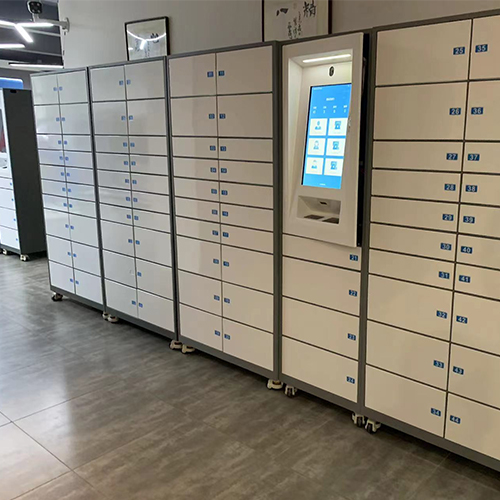Intelligent lockers, as crucial equipment in modern logistics, retail, and office applications, directly impact user experience and operational efficiency through their stability and reliability. Reducing the failure rate of intelligent lockers not only lowers maintenance costs but also enhances user satisfaction. The following section discusses in detail how to effectively reduce the failure rate of intelligent lockers from multiple aspects, including design, manufacturing, use, and maintenance.

I. Optimized Design Phase
Modular Design
Modular Structure: Designing key components of the intelligent locker with a modular structure facilitates replacement and maintenance. For example, locks, sensors, and displays can be designed as independent modules. If one module fails, only that module needs to be replaced without affecting the normal operation of other components.
Standardized Interfaces: Employing standardized interface designs ensures compatibility between modules and reduces failures caused by interface incompatibility.
Redundant Design
Redundancy of Critical Components: For critical components, such as power supplies and communication modules, redundant designs can be adopted to ensure that backup components can immediately take over when the primary component fails, guaranteeing the normal operation of the intelligent locker.
Dual Power Supply: A dual power supply system is designed so that if one power source fails, the other can immediately switch, preventing downtime due to power failure.
Environmental Adaptability Design
Dustproof and Waterproof Design: The intelligent cabinet is designed with appropriate dustproof and waterproof ratings based on its operating environment, ensuring normal operation even in harsh conditions. For example, outdoor intelligent cabinets should have a high IP protection rating to prevent rain and dust ingress.
Temperature Control: In high or low temperature environments, the intelligent cabinet should have an internal temperature control system to ensure electronic components operate within a suitable temperature range, preventing malfunctions caused by excessively high or low temperatures.
II. Improving Manufacturing Quality
Strict Quality Control
Raw Material Selection: Raw materials are rigorously selected during the manufacturing process to ensure they meet design requirements, preventing malfunctions due to material quality issues.
Production Process Control: Production processes are optimized to ensure quality control at every stage, reducing product defects caused by human error or equipment malfunction during production.
Automated Production
Automated Assembly: Automated assembly lines are used to reduce human error and improve product consistency and reliability.
Automated Testing: Automated testing equipment is installed at the end of the production line to perform multi-faceted functional tests on each intelligent cabinet, ensuring the quality of products leaving the factory.
Aging Test
Long-Term Operation Test: Before leaving the factory, the intelligent cabinets undergo long-term aging tests to simulate real-world usage environments, detect potential fault points, and ensure product stability in actual use.
Extreme Environment Test: Tests are conducted in extreme environments, such as high temperature, low temperature, and high humidity, to ensure the intelligent cabinets can operate normally under various conditions.
III. Optimized Use and Maintenance
User Training
Operational Training: Detailed operational training is provided to users to ensure they can use the intelligent cabinets correctly and avoid malfunctions caused by improper operation.
Troubleshooting Training: Users are trained on basic troubleshooting methods, such as restarting and checking connections, to reduce downtime caused by minor issues.
Regular Maintenance
Regular Inspection: A regular inspection plan is developed to inspect key components of the intelligent cabinets, such as locks, sensors, and power supplies, to promptly identify and address potential problems.
Cleaning and Maintenance: The intelligent cabinets are cleaned regularly, especially those used outdoors, to prevent malfunctions caused by dust and dirt accumulation. Remote Monitoring and Maintenance
Remote Monitoring System: Install a remote monitoring system in the intelligent cabinet to monitor its operational status in real time, promptly detect and handle faults.
Remote Diagnosis and Maintenance: Through the remote diagnostic system, technicians can remotely analyze the causes of faults and guide users through simple maintenance operations, reducing the need for on-site maintenance.
IV. Data Analysis and Feedback
Fault Data Analysis
Fault Records: Record detailed information such as the time of occurrence, cause, and handling process of each fault, establishing a fault database.
Data Analysis: By analyzing fault data, identify commonalities and patterns in faults, providing a basis for subsequent design improvements.
User Feedback
User Feedback Collection: Establish a user feedback mechanism to collect problems and suggestions encountered by users during use.
Feedback Processing: Process user feedback promptly to improve product design and services, enhancing user satisfaction.
V. Continuous Improvement
Design Iteration
Improvement Based on Feedback: Continuously optimize the design of the intelligent cabinet based on fault data and user feedback, improving product reliability and stability.
New Technology Application: Focus on the development of new technologies, such as the Internet of Things (IoT) and artificial intelligence (AI), and apply them to the design of intelligent cabinets to enhance the product's intelligence level.
Supply Chain Management
Supplier Evaluation: Regularly evaluate supplier quality and delivery capabilities to ensure supply chain stability.
Component Updates: Update intelligent cabinet components promptly as technology advances, using more advanced and reliable parts to improve overall performance.
Conclusion
Reducing the failure rate of intelligent cabinets requires a multi-pronged approach, addressing design, manufacturing, use, and maintenance. Optimizing design, improving manufacturing quality, optimizing use and maintenance, data analysis and feedback, and continuous improvement can effectively reduce the failure rate, enhance product reliability, and improve user satisfaction. Only through comprehensive efforts can we ensure the stable operation of intelligent cabinets in various environments, providing users with efficient and convenient services.

















 WhatsApp
WhatsApp Phone
Phone
Comment
(0)